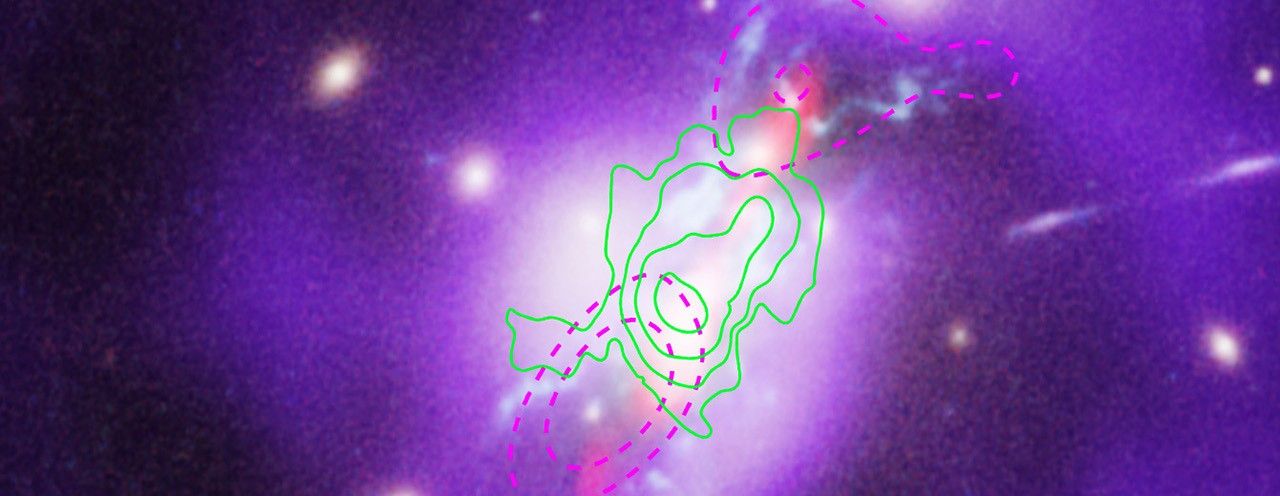
New Findings Confirm Long-Standing Hypothesis About the Galaxy Feeding Cycle.
Scientists utilizing NASA’s James Webb Space Telescope have uncovered the secrets behind the rapid star formation occurring within a massive galaxy cluster. This breakthrough builds upon over ten years of research conducted with the Chandra X-ray Observatory, Hubble Space Telescope, and various ground-based observatories.
The Phoenix cluster, located 5.8 billion light-years away from our planet, is a fascinating collection of galaxies held together by gravity. Astronomers have been particularly intrigued by its unique characteristics, namely the unexpected cooling of gas and an intense rate of star creation. This is especially notable given the presence of a supermassive black hole at its center, roughly 10 billion times the mass of our Sun. In contrast to other studied clusters, where the energy generated by the central black hole prevents gas cooling essential for star formation, the Phoenix cluster presents a puzzling phenomenon. Researchers have been investigating the flow of gas within this cluster to unravel how it supports such extraordinary star formation.
“Our earlier investigations into the Phoenix cluster revealed varying cooling rates at different temperatures, which we liken to a ski slope,” explained Michael McDonald from the Massachusetts Institute of Technology, the principal investigator of this project. “The Phoenix cluster boasts the largest reservoir of hot, cooling gas compared to any other galaxy cluster—similar to having an extremely busy ski lift bringing numerous skiers to the mountain’s summit. However, not all skiers were reaching the bottom, indicating that not all the gas cooled sufficiently. If there were significantly more people disembarking at the top than arriving at the bottom, that would indicate an issue!”
Thus far, researchers have struggled to piece together the puzzle in the Phoenix cluster, as the data did not quite align. However, the Webb telescope has successfully tracked down the missing cooling gas—termed the “skier” in this analogy—that ultimately fuels star formation. Crucially, this intermediary warm gas has been identified within cavities surrounding extremely hot gas, reaching temperatures of about 18 million degrees Fahrenheit, as well as the already cooled gas at approximately 18,000 degrees Fahrenheit.
The research team examined the cluster’s core with unprecedented detail using the Medium-Resolution Spectrometer on Webb’s Mid-Infrared Instrument (MIRI). This advanced instrument enables scientists to gather two-dimensional spectroscopic information from specific regions of the sky during a single observational session.
“Prior studies only assessed gas at the extremes of the temperature spectrum within the cluster’s center,” McDonald noted. “We faced limitations in detecting the ‘warm’ gas we were aiming to study. With Webb, for the first time, we could successfully identify this gas.”
Webb’s ability to detect this specific temperature of cooling gas, approximately 540,000 degrees Fahrenheit, is due, in part, to the telescope’s advanced technology. Additionally, nature plays a supportive role in this discovery.
This intriguing phenomenon involves two different ionized elements, neon and oxygen, which arise from similar environments. Under these temperature conditions, the emission from oxygen is significantly brighter but is only detectable in ultraviolet light. Although neon is fainter, it emits in the infrared spectrum, allowing researchers to leverage Webb’s cutting-edge instruments for detection.
“In the mid-infrared wavelengths captured by Webb, the signature from neon VI was remarkably pronounced,” shared Michael Reefe, also from MIT and the lead author of the study published in Nature. “Even though this emission is typically challenging to detect, Webb’s heightened sensitivity in the mid-infrared effectively cuts through the noise.”
The research team now aspires to apply this method to investigate more typical galaxy clusters. While the Phoenix cluster possesses unique characteristics, this proof of concept marks a critical advancement toward understanding how other galaxy clusters generate stars. The James Webb Space Telescope stands as the foremost space science observatory worldwide, unraveling mysteries within our solar system, exploring distant worlds surrounding other stars, and probing the enigmatic structures and origins of our universe. This initiative is a collaborative global effort spearheaded by NASA in partnership with ESA (European Space Agency) and CSA (Canadian Space Agency).
Downloads
Right-click any image to save or view a larger version in a new tab or window from your browser’s popup menu.
Access/Download all image assets in various resolutions related to this article from the Space Telescope Science Institute.
Explore the research in the study published in Nature.
Contact Information:
Laura Betz – laura.e.betz@nasa.gov
NASA’s Goddard Space Flight Center, Greenbelt, MD.
Hannah Braun – hbraun@stsci.edu
Space Telescope Science Institute, Baltimore, MD.
Christine Pulliam – cpulliam@stsci.edu
Space Telescope Science Institute, Baltimore, MD.
Related Articles: Large-scale Structures, Phoenix Galaxy Cluster’s black hole, Spectroscopy 101
Learn About the Webb Telescope
En Español









